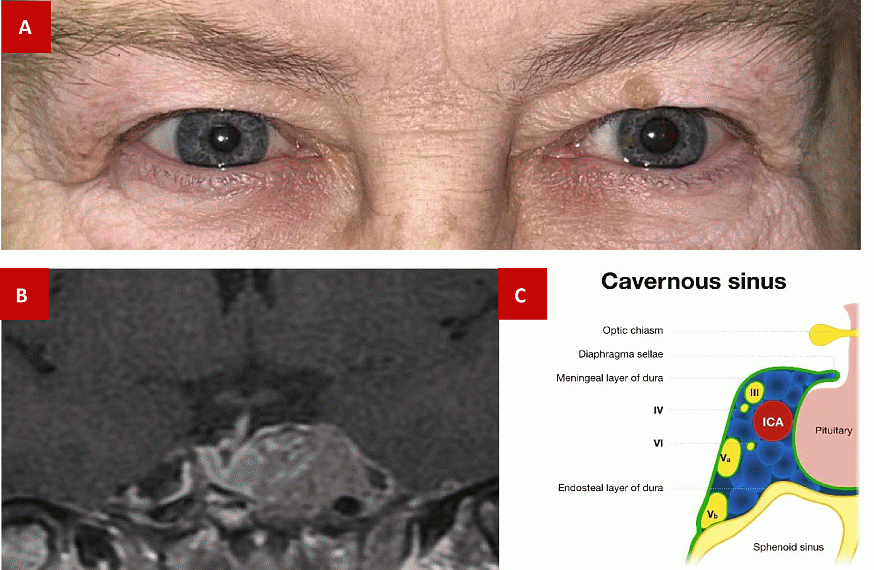BES2023 BES 2023 Section (29 abstracts)
Unilateral mydriasis as a first presentation of pituitary macroadenoma
Ailliet Tim 1 , Cools Axelle 2 , Van Haecke Helena 3 , Vantomme Nikolaas 4 , Vandelanotte Sylvie 2 & Van Den Bruel Annick 1
1Department of Endocrinology, AZ Sint-Jan Brugge, Brugge, Belgium; 2Department of Ophthalmology, AZ Sint-Jan Brugge, Brugge, Belgium; 3Department of Ophthalmology, UZ Gent, Gent, Belgium; 4Department of Neurosurgery, AZ Sint-Jan, Brugge, Belgium
Background: Pituitary adenomas are the most prevalent tumours in the sellar region and can either be functioning, with autonomous pituitary hormone secretion, or non-functioning. Clinically evident adenomas occur in 1 in 1,100 in the general population. Pituitary adenomas have traditionally been subdivided into microadenomas (<10 mm) or macroadenomas (≥ 10 mm), with macroadenomas comprising 48% of clinically relevant adenomas. Non-functioning pituitary macroadenomas (NFPM) typically present with visual field defects, headache, and/or hypopituitarism secondary to local mass effect. The current recommended first-line therapy for NFPM is transsphenoidal surgery [1].
Case: A 62-year-old female consulted the neurosurgery clinic following a referral by her private practice ophthalmologist and neurologist with complaints of new-onset left unilateral mydriasis. Her medical history consisted of chronic tension headache, arterial hypertension, and diabetes mellitus type 2. She denied recent worsening of her headache, blurry vision, or visual field defects. Physical examination confirmed a unilateral left-sided mydriasis non-reactive to light (Figure 1, panel A). Additional ophthalmologic and neurologic examination was unremarkable. Magnetic resonance imaging (MRI) of the brain showed a large pituitary macroadenoma with invasion of the left cavernous sinus (Figure 1, panel B ). Biochemical evaluation showed no signs of hormonal hyper- or hyposecretion. After obtaining informed consent, the patient underwent transsphenoidal endoscopic pituitary adenoma resection. Post-operative computed tomography (CT) scan showed a residual nodular component at the level of the left cavernous sinus, most compatible with tumour remnant. The anatomopathological examination was compatible with a pituitary adenoma. The mydriasis persisted post-operatively.
Discussion: To our knowledge, this is the first case report describing new-onset unilateral mydriasis as the first presentation of a NFPM. However, acute ophthalmoparesis as a presenting symptom of pituitary adenoma has been described before [2,3]. The oculomotor nerve is the most medial cranial nerve in the lateral wall of the cavernous sinus (Figure 1, panel C) [2]. It is responsible for most eye movements and carries parasympathetic fibers that innervate the sphincter pupillae muscle. Contraction of this muscle causes miosis. Theoretically, compression of these fibres could result in the loss of papillary constriction, resulting in mydriasis. The anatomical proximity of the oculomotor nerve to the pituitary gland suggests that external pressure by the macroadenoma may have contributed to the observed mydriasis in this case.

Figure 1. Left unilateral mydriasis (A). Pituitary macroadenoma invading the left cavernous sinus (B). Anatomy of the cavernous sinus showing the relation between the pituitary gland and the oculomotor nerve, courtesy of Frank Gaillard, Radiopaedia.org, rID: 54907 (C)
Conclusion: Our case report highlights a peculiar presentation of a NFPM with new-onset unilateral mydriasis. While ophthalmoparesis involving the oculomotor nerve has been previously documented, this specific manifestation of oculomotor nerve dysfunction in relation to NFPM has not been reported before. This case emphasizes the importance of considering pituitary macroadenomas as a potential cause of unexplained ophthalmologic symptoms, even in the absence of hormonal abnormalities.
References: 1. Tritos NA, Miller KK. Diagnosis and Management of Pituitary Adenomas: A Review. JAMA. 2023 Apr 25;329(16):1386-1398.2. Natarajan D, Tatineni S, Ponnapalli SP, Sachdeva V. Pituitary adenoma presenting as acute onset isolated complete third cranial nerve palsy without vision changes. BMJ Case Rep. 2020 Jun 24;13(6):e232490.3. Varma D, Tesha P, George N. Acute painful third nerve palsy: the sole presenting sign of a pituitary adenoma. Eye (Lond). 2002 Nov;16(6):792-3.
 }
}



